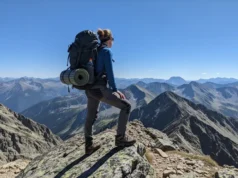In this article
Choosing the right hiking shorts can be overwhelming. Faced with a wall of technical jargon, high price tags, and endless options, it’s easy to waste money on a pair that leads to chafing, discomfort, and regret halfway up the trail. This isn’t just about clothing; it’s about the quality of your experience in the wild. A bad pair of shorts can turn a beautiful trek into a miserable ordeal.
This guide is designed to cut through that noise. We’re here to give you the confidence that comes from genuine expertise and rigorous, independent testing. Here’s our promise to you:
- Learn the fundamentals: We’ll demystify the key features that truly matter—from fabric science to fit—so you can evaluate any pair of shorts like an expert.
- See the data: We’ll transparently share our 100+ mile testing protocol, showing you exactly how we identified the top performers.
- Get the right gear: Find the perfect shorts for your specific hiking style, whether you’re a weekend warrior, one of the many long-distance hikers tackling a thru-hike, or an off-trail scrambler.
What Truly Matters in a Mens Hiking Shorts?
This section will arm you with the essential knowledge to look past the marketing hype and make a smart, informed decision based on real performance attributes. Understanding these core principles is the first step toward trail comfort when selecting the right mens hiking shorts.
Why Do Material and Fabric Construction Matter So Much?
The fabric of your shorts is the first line of defense against the elements and the primary factor in your comfort. Modern hiking shorts are products of material science, engineered to perform under stress. The gold standard is a strategic blend of Nylon and Spandex. Nylon provides exceptional durability, crucial for resisting scrapes against rock and brush, while Spandex offers the mechanical stretch needed for high steps and unrestricted mobility. Polyester is a strong alternative, often excelling at wicking sweat away from the skin, which makes it a great choice for high-humidity conditions during the summer or on particularly wet hikes.
This reliance on synthetics is a core principle for all high-performance outdoor clothing and is built on a core trail principle: “cotton kills.” Cotton is highly absorbent; it soaks up sweat and rain and holds that moisture against your skin. This not only creates the perfect environment for painful chafing but can also pose a serious hypothermia risk in changing weather, as the wet fabric leeches heat from your body. For this reason, cotton should be avoided at all costs. Beyond the base material, look for two critical features. A UPF rating of 40+ is a non-negotiable safety feature, blocking harmful UV radiation on exposed ridgelines and at high altitudes. Unlike sunscreen, this protection doesn’t sweat off or need reapplication, as confirmed by research into the UV protection factor of textiles. Additionally, a Durable Water Repellent (DWR) finish is key. This chemical coating causes light rain and water splashes to bead up and roll off, keeping the shorts lighter and allowing them to dry much faster if they do get wet, as we detail in our complete guide to hiking shorts.
How Do Fit and Mobility Prevent Discomfort on the Trail?
A perfect fabric is useless if the shorts don’t move with your body. The single most important feature for mobility is the gusseted crotch. This diamond-shaped panel of fabric sewn into the inseam replaces a restrictive four-way seam junction. The difference is dramatic, allowing for a full range of motion that prevents the shorts from binding or pulling when you’re climbing over a fallen log or scrambling up a steep rock face; the best shorts move with you, never against you.
The waistband design is equally critical, especially when wearing a backpack. A poorly designed waistband with bulky hardware or thick seams will create painful pressure points and hot spots under the pressure of a loaded hip belt. The best hiking shorts feature flat, soft-lined waistbands, a dedicated hiking belt on loops, integrated webbing belts, or smooth internal drawstrings to eliminate this issue. Finally, consider inseam length as a balance between protection and airflow. Longer inseams of around 9 to 11 inches offer more protection from sun and brush and can help prevent thigh chafing. Shorter inseams, typically 5 to 7 inches, provide maximum ventilation and a feeling of freedom, making them ideal for hot weather or faster-paced hikes. This ultimately comes down to personal preference and the type of terrain you frequent, but it’s a critical part of a complete sun protection system that includes more than just sunscreen. It’s a key piece of gear to consider when you think about what to bring on a hike and is part of the ongoing discussion around the industry’s move away from harmful chemicals in DWR coatings.
How We Tested and What We Looked For
To earn your trust, we believe in absolute transparency. Our recommendations aren’t based on catalog specs or brand reputation alone; they are the direct result of rigorous on-trail testing and a hands-on evaluation process designed to replicate the real-world demands you place on your gear.
Our first commitment is to objectivity. We buy all the products we test ourselves at retail, just like you would. This ensures our primary loyalty is to you, the reader, not to any specific brand or manufacturer. Our conclusions are independent, unbiased, and driven by one thing only: performance on the trail.
Every pair of shorts that enters our testing pool is judged against the critical performance attributes we detailed above. We established a clear evaluation framework focused on durability under stress, mobility in dynamic movements, real-world comfort over long miles, weather resistance, and overall value. We don’t just look at the features; we measure how those features translate into a better hiking experience.
Our testing methodology is grounded in the real world. Each pair was field-tested by our team for over 100+ combined miles across a wide range of challenging trails and environments. We subjected them to everything from humid multi-day treks in the Appalachians to high-altitude day hikes on a Colorado mountain to assess their true durability and resistance to snags.
The final step is to translate all this performance data into practical advice. The goal of our exhaustive process is to generate the clear, practical, and persona-based recommendations that follow. We did the hard work so you can be confident you’re getting the right gear for your specific needs, your budget, and your next adventure.
The Best Mens Hiking Shorts of 2025: Our Top Picks
Here are our top recommendations, field-tested and categorized to match your unique hiking style and needs. Each pair has proven its worth where it counts: on the trail.
Hiking Short Comparison
Find the perfect hiking shorts for your next adventure!
Material
Recycled Polyester, Elastane
Best For
Maximum breathability & minimal weight
Material
Recycled Nylon, Spandex
Best For
Unmatched comfort & mobility
Material
Recycled Nylon, Spandex
Best For
Extreme durability & utility
Material
Recycled Polyester, Nylon
Best For
Affordability & storage
Best for The Thru-Hiker/Ultralight Enthusiast
The North Face Wander 2.0 Short is the ultimate choice for hikers who prioritize minimal weight and maximum breathability for long-distance efficiency. With excellent weight/packability, these ultralight shorts weigh an incredibly light 4.4 oz and pack down to almost nothing, a critical factor for any ultralight setup. The construction features a recycled polyester/elastane blend with FlashDry-XD™ technology, which excels at moisture management; in our tests, these North Face Wander shorts dried in under 30 minutes after a soaking. Its mobility is excellent, and the simple, flat elastic waistband with an internal drawstring is exceptionally comfortable, creating zero pressure points under a pack’s hip belt. These shorts are purpose-built for crushing miles on long-distance thru-hikes in warm weather.
The trade-off for its minimalist design is in its ruggedness and features. The thin fabric offers minimal protection from abrasive terrain like sharp granite or thorny brush, and the pocket system—two open hand pockets and a small zippered back pocket—is too basic for hikers who need secure, accessible storage for maps or devices.
PROS
- Extremely lightweight and packable
- Excellent moisture-wicking
- Dries in under 30 minutes
- Flat waistband is pack-friendly
- Great value for performance
CONS
- Thin fabric lacks durability
- Minimalist pocket system
- Not ideal for cool or windy weather
- Fabric can feel ‘swishy’
Best for The Weekend Warrior/All-Around Adventurer
As the best all-round hiking shorts we tested, the Outdoor Research Ferrosi Short is in a class of its own for the hiker who values freedom of movement and next-to-skin comfort above all else. Its legendary performance comes from a lightweight, breathable, and abrasion-resistant soft-shell fabric with a high 14% spandex content, providing best-in-class stretch that moves with you effortlessly. The fit is dialed for activity, but the standout feature for hikers is the soft, brushed tricot-lined waistband, specifically designed to eliminate hot spots and chafing under a backpack hip belt. With five total pockets, including two zippered options for security, it’s as functional as it is comfortable.
The Ferrosi’s incredible comfort and breathability come with a slight trade-off in ultimate durability. While it’s tough enough for most trail conditions, the fabric is more susceptible to snags and pilling from heavy bushwhacking or contact with sharp rock compared to tougher, pure nylon weaves. It’s the perfect do-it-all short with a great town-to-trail style, but it’s not a suit of armor.
PROS
- Unmatched comfort and mobility
- Highly breathable and quick-drying
- Soft, pack-compatible waistband
- Versatile for many activities
- Effective UPF 50+ sun protection
CONS
- Less durable than heavier shorts
- Pockets can sag when loaded
- Sizing can feel inconsistent
- Internal drawcord can be finicky
Best for The Rugged Explorer/Off-Trail Scrambler
The Prana Stretch Zion II (often just called Prana Zion shorts) is a legendary and updated short that offers a fantastic blend of ruggedness and utility, making it the ideal choice for long treks on tough, unpredictable trails where trail utility is paramount. Its reputation is built on Prana’s proven ReZion™ fabric, a recycled nylon blend known for its long-term, abrasion-resistant durability, making them a top choice as rock shorts for climbers and scramblers. It features an integrated, low-profile webbing belt that cinches down securely and remains completely unobtrusive and comfortable under a pack’s hip belt. The pocket layout is a masterclass in utility, with six total pockets including two secure zippered options and a brilliant double-entry zippered cargo pocket on the thigh for easy access.
This impressive durability and feature set come at the cost of weight. At 9.7 ounces, it is one of the heaviest shorts in its class, which may be a significant drawback for ultralight hikers or those focused on minimizing every gram. While the fabric is water-repellent, it can feel heavier and take longer to dry than lighter options when fully saturated.
PROS
- Exceptional durability and abrasion resistance
- Excellent integrated belt system
- Great pocket layout with secure storage
- Ventilated gusset enhances mobility
- Versatile for trail and town
CONS
- Heavier than most other models
- Slower to dry when saturated
- Can feel less breathable in heat
- Some users dislike updated plastic button
Best Budget Option
The Columbia Silver Ridge Cargo short, one of the most popular budget-friendly hiking shorts available, has been a gateway to the outdoors for countless hikers, and for good reason. These affordable hiking shorts deliver reliable trail performance at an unbeatable price. Made from a lightweight nylon and recycled polyester fabric with Columbia’s Omni-Wick technology, it breathes well and dries reasonably fast. As the name implies, the standout feature for these cargo shorts is storage, boasting multiple hook-and-loop cargo and back pockets, plus a zippered security pocket. For day hikers who want to keep essentials handy without breaking the bank, it’s a fantastic starting point that also provides UPF 50 sun protection.
However, the budget price point comes with compromises. The fit is much baggier and less athletic than premium shorts, and the fabric lacks the stretch and mobility of a nylon/spandex blend. While adequate for maintained trails, its durability isn’t suited for rugged, off-trail scrambling.
PROS
- Excellent value for the price
- Ample cargo pocket storage
- Lightweight and breathable
- UPF 50 sun protection
- Includes a simple web belt
CONS
- Baggy, non-athletic fit
- No stretch in the fabric
- Lower durability than premium options
- Velcro pockets are less secure
Final Considerations & Common Mistakes to Avoid
Before you click “buy,” run through this final checklist. It will help you avoid the common purchasing errors that lead to discomfort and ensure you get the perfect pair of new shorts for your needs.
Don’t Assume Your Size: Sizing is notoriously inconsistent between brands. A “Medium” in one brand can be a “Large” in another, so always check the chart when comparing different shorts. Pay close attention not just to waist size but also to the offered inseam measurements.
Liner vs. No Liner: This is a purely personal choice. Some hikers prefer the convenience of a built-in brief liner, similar to running shorts, for simplicity and chafe-prevention. Others prefer the versatility of wearing their own preferred performance underwear. There is no right answer, only what works for you.
Pocket Placement is Key: Think about how you’ll actually use the shorts on the trail. Will the pockets be accessible when you’re wearing a backpack with a cinched hip belt? A great thigh cargo pocket is useless if it’s pinned shut. If you can, test this with your own pack.
Match Durability to Your Hike: Be honest about your hiking style. Don’t overpay for “bombproof” durability if you primarily stick to easy hikes, but don’t buy an ultralight, paper-thin short if you plan on intense hiking through granite fields or bushwhacking off-trail.
Frequently Asked Questions about Mens Hiking Shorts
What is the difference between hiking shorts and regular shorts?
Hiking shorts are engineered for performance on the trail. They use durable, quick-drying synthetic materials like nylon and spandex and incorporate design features like gusseted crotches and flat waistbands for enhanced mobility and comfort under a pack. Unlike casual everyday shorts or gym shorts, they prioritize technical attributes like DWR water resistance and UPF sun protection, making a purpose-built model like the Outdoor Research Ferrosi far superior for any outdoor adventure.
Are expensive hiking shorts worth it?
For dedicated hikers, yes, the investment is absolutely worth it. The price reflects significant gains in comfort, durability, and safety. A premium pair prevents painful chafing, protects you from the sun, and moves with your body instead of against it. Top-tier models like the Patagonia Quandary shorts use higher-quality, often recycled materials and more robust construction techniques that last longer and perform better under stress, ultimately providing better value over many seasons of use.
What material is best for hiking shorts?
A blend of nylon and spandex is generally the best combination for most hikers. This pairing offers an ideal balance of rugged durability from the nylon and flexible, four-way stretch from the spandex. This allows the shorts to withstand abrasion from rock and brush while never restricting your movement. Products like the Kuhl Renegade are excellent examples of a design that uses a high-quality nylon-based weave purpose-built for trail abuse.
How should hiking shorts fit?
Athletic hiking shorts should have a fit that is trim but unrestrictive. They should be snug enough at the waist to stay in place without sagging, but offer complete freedom of movement through the hips and thighs. The critical test is being able to take a high step, as if climbing onto a large boulder, without the fabric binding or pulling. Pay close attention to the waistband; it must lie flat and comfortably under your backpack’s hip belt without creating any pressure points.





